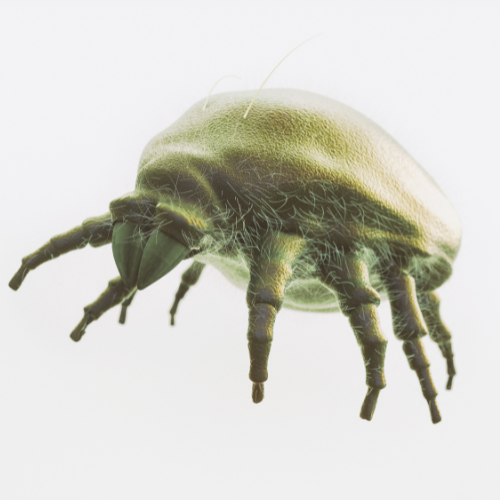House Dust Mite

Proud Supporter of Disabled Veterans
No Contracts
Services provided without written contracts.
Introduction to
House dust mites are microscopic creatures that thrive in household dust, feeding on the dead skin cells shed by humans and pets. These tiny arachnids are a common cause of allergic reactions and asthma, making them a significant concern for many households. Understanding the biology, habits, and effective prevention methods for house dust mites is crucial for maintaining a healthy indoor environment. By controlling dust mite populations, you can reduce allergy symptoms and improve overall air quality in your home.
Recognition
House dust mites are extremely small, typically measuring 0.2 to 0.3 mm in length, making them invisible to the naked eye. They have a translucent, creamy-white color and a soft, oval-shaped body with eight legs. Unlike other mites, house dust mites do not have eyes or antennae. They are often found in household dust, which can be collected and examined under a microscope for accurate identification. The presence of house dust mites is usually indicated by allergy symptoms in residents, such as sneezing, runny nose, itchy eyes, and asthma attacks, rather than direct visual identification.
Biology
House dust mites undergo a lifecycle that includes four stages: egg, larva, nymph, and adult. Females lay eggs singly or in small groups, which hatch into six-legged larvae. The larvae then molt into eight-legged nymphs and eventually develop into adults. The entire lifecycle takes about one month under optimal conditions, which include high humidity and moderate temperatures. House dust mites feed primarily on organic matter, particularly skin flakes shed by humans and pets. They thrive in warm, humid environments and are commonly found in bedding, upholstered furniture, and carpets, where skin cells accumulate.
Habits
House dust mites prefer warm, humid environments and are most commonly found in areas where people and pets spend a lot of time, such as bedrooms and living rooms. They thrive in temperatures between 20-25°C (68-77°F) and humidity levels above 50%. Dust mites feed on skin flakes and other organic debris found in household dust. They can also be found in mattresses, pillows, and soft furnishings, where they burrow deep into fibers. Dust mites do not bite or burrow into skin, but their presence can cause allergic reactions due to the proteins found in their feces and body parts.
Prevention
Preventing house dust mite infestations involves reducing humidity and controlling dust accumulation in the home. Use a dehumidifier or air conditioner to maintain humidity levels below 50%. Wash bedding, curtains, and stuffed animals in hot water (at least 130°F) weekly to kill dust mites. Encase mattresses and pillows in allergen-proof covers to prevent mites from colonizing these areas. Vacuum carpets, rugs, and upholstery regularly using a vacuum cleaner with a HEPA filter. Reduce clutter and dust-prone surfaces, and consider replacing carpets with hard flooring in bedrooms and other high-risk areas.
Professional
If house dust mites cause significant allergic reactions or asthma symptoms, professional pest control services can provide effective solutions. STL Pest Control offers comprehensive treatments to reduce dust mite populations and improve indoor air quality. Their technicians are trained to identify dust mite hotspots and apply appropriate control measures, including specialized cleaning and allergen reduction techniques. In severe cases, they may recommend ongoing maintenance plans to keep dust mite levels manageable. Professional services ensure thorough and long-lasting control, providing peace of mind and a healthier living environment.



Our Office







